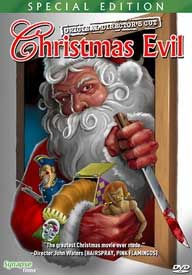 The ultra low-budget Troma film Christmas Evil (1980), is a comedy of holiday horrors, & a whole lot better than one expects Troma films to be.
The ultra low-budget Troma film Christmas Evil (1980), is a comedy of holiday horrors, & a whole lot better than one expects Troma films to be.
One Christmas morning, a little boys snuck down the staircase & caught mommy & Santa having a sexual encounter by the Christmas tree. Freaked out, he hid in the attic, angrily broke a snowglobe, then used a piece of the glass to carve into his own hand.
Thus are twisted psyches born. That kid grew up with a sicko Christmas fetish. His hobby is being an obsessive peeping tom watching children like some pervert, though it's only so that he can make a list, check it twice, documenting who has been naughty or nice.
He works at a cheapjack plastic toy factory. He dreams of making grand toys, but it'll never happen at this horrible place.
Without a wife or kids of his own, & no friendships to speak of, Christmas gets pretty weird for a guy who decorates his apartment with Santa geegaws year round. His brother's family would be glad to include him, but our guy is focused on his own introverted life.
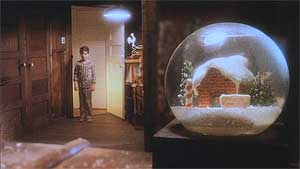 What with peeping at children & decorating his lonesome dwelling, it was only a matter of time before he snapped & began to take his private gloom out on the world. What with peeping at children & decorating his lonesome dwelling, it was only a matter of time before he snapped & began to take his private gloom out on the world.
Suspense definitely arises from the worry about what he'll do when he starts supplying rewards & punishments in accordance with his two big books of "Good" children & "Bad" children. An imaginative soundtrack underscores the twisted psychology & events.
With toys stolen from the company where he works, he prepares for his housebreaking Christmas Eve. Super-gluing his Santa beard to his face, & getting all decked out in his home-sewn Santa suit, he drives about town in his van full toys & imagines himself in a reindeer-drawn sleigh.
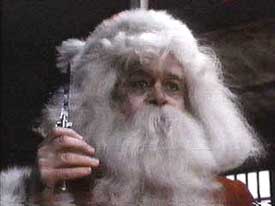 At first he makes an appealing traditional Santa breaking into a home to pile up gifts for the good kids. Even leaving a bag of dirty for the worst kid in the neighborhood isn't all that terrible. At first he makes an appealing traditional Santa breaking into a home to pile up gifts for the good kids. Even leaving a bag of dirty for the worst kid in the neighborhood isn't all that terrible.
His first outright victims, killed with toys, include the guy from the toy company who did a "charity" promotion for retarded orphans, but it was only for the publicity, he didn't really do anything for the kids. That made Santa mad.
An hysterical & yet disturbing scene has him so convinced he really is Santa that he believes he can get into a house through the chimney. He only manages to get himself wedged in the hole, & when he luckily pries himself out, his beautifully crafted Santa suit is all sooty.
On Christmas day's evening, he's still doing Santa, but after two days of insane activity, he is soiled, blood-spattered, & the whole town is on the lookout for Psycho Santa.
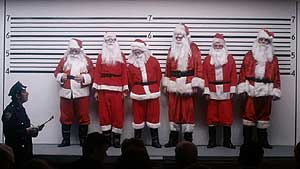 In a marvelous satire on a traditional horror scenario, an entire neighborhood armed with burning torches pursues him. In a marvelous satire on a traditional horror scenario, an entire neighborhood armed with burning torches pursues him.
The film ends with a startling moment I shan't reveal. But this film is overall much more than usual "so bad it's good" variety. It has real heart & a central performance which completely transcends the Z budget.
Even though on the surface this is a parody of Christmas movies & slashers, with humorous intent, Harry is so troubled that his deterioration definitely provide a strong dose of tragedy.
The central performance that makes it work belongs to Brandon Magger's as Harry. Whether he's in sweet innocent Santa mode, or dangerous lunatic Santa mode, he's totally convincing, & can go from one extreme to the next in a single scene with surprising subtlty in the transition. Without his performance the film might not have been much; but with him, it's a Christmas treasure.
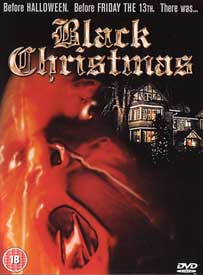 Bob Clark directed one of the greatest Christmas movies for the family with A Christmas Story (1983), on just about everyone's top-ten list of holiday bests. Bob Clark directed one of the greatest Christmas movies for the family with A Christmas Story (1983), on just about everyone's top-ten list of holiday bests.
Yet it seems like only die-hard horror fans realize he also directed one of the best horror films for the season, Black Christmas (1974), not to be confused with its horrible remake.
Predating Halloween (1978), Friday the 13th (1980), & Nightmare on Elm Street (1984), some regard Black Christmas as the true beginning of slasher cinema. The suspense is built around an unseen killer, & it delivers a twist ending.
And instead of the usual B film cast of nobodies, this one has a cast to die for: Olivia Hussey as the heroine who grabs the fireplace poker & heads upstairs at the critical moment when the smart thing would've been to leave the house; Keir Dulea as her boyfriend who might or might not have something to do with the terrors; with excellent supporting performances from Margot Kidder the trash-talker with nothing to do for Christmas so taking it out on her fellow drunkard, the sorority's house mother (Marion Waldman); Lynne Griffin as the first victim; & as the police lieutenant, John Saxon -- good performances all round.
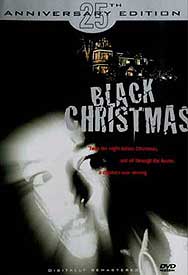 Considering that it was made on the cheap, Black Christmas has fairly slick production values & is often shot from the unseen killer's point of view. This subjective viewpoint was at the time so innovative that some critics assessed it as an experimental film. Considering that it was made on the cheap, Black Christmas has fairly slick production values & is often shot from the unseen killer's point of view. This subjective viewpoint was at the time so innovative that some critics assessed it as an experimental film.
The subjective eye was soon to become de rigour whether the villain was a psycho killer or a shark, Jaws having been made the following year. And like both Halloween & Jaws, it likewise had a brilliant simple score that heightens shock & horror.
The lasting influence of this film can also be detected in the manner by which Black Christmas's eerie, growly phone calls from the killer aspected later films from A Stranger Calls (1979) to Scream (1996).
A peeping tom has gained access to the sorority house's attic crawlspace. From his secret residence, he begins to pick off the girls one by one during the Yuletide season. That's pretty much the whole plot, but within that minimalist story are several fine character performances & a hell of a lot of fearful tension.
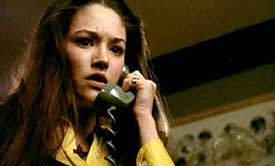 Kidder's collection of glass animals imitates that of Laura from Tenessee Williams' The Glass Menagerie, down to the special significance of the unicorn. Kidder's collection of glass animals imitates that of Laura from Tenessee Williams' The Glass Menagerie, down to the special significance of the unicorn.
It's through this collection of glass beass that we first glimpse a bit of the killer's face, but only his left eye is lit, just one of dozens of arty moments heightening creepiness.
There's a lot of humor, whether in the housekeeper's alcoholism; the Santa with the "Ho ho ho, fuck" for the kids; or Margot Kidder & Andrea Martin as a kind of comic relief Greek chorus. But of course it's the suspense that most matters. As the humor stems from characters, it does not undermine or conflict with the suspense.
Black Christmas must've seemed a case of extreme exploitation violence in 1974, but violence has become amped by factors of thousands in today's films. That hasn't weakened Black Christmas so much as placed appreciative focus on subtler elements, as it now views more purely as a moody suspense thriller, as though it had been inspired by such quietly disturbing films of psychosis as That Cold Day in the Park (1969), Pretty Poison (1968) or The Mad Room (1969), rather than by Hitchock's Psycho.
copyright © by Paghat the Ratgirl
|
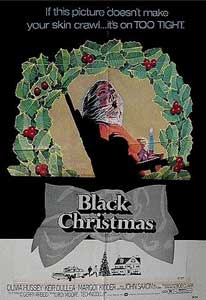

 What with peeping at children & decorating his lonesome dwelling, it was only a matter of time before he snapped & began to take his private gloom out on the world.
What with peeping at children & decorating his lonesome dwelling, it was only a matter of time before he snapped & began to take his private gloom out on the world. At first he makes an appealing traditional Santa breaking into a home to pile up gifts for the good kids. Even leaving a bag of dirty for the worst kid in the neighborhood isn't all that terrible.
At first he makes an appealing traditional Santa breaking into a home to pile up gifts for the good kids. Even leaving a bag of dirty for the worst kid in the neighborhood isn't all that terrible. In a marvelous satire on a traditional horror scenario, an entire neighborhood armed with burning torches pursues him.
In a marvelous satire on a traditional horror scenario, an entire neighborhood armed with burning torches pursues him.
 Considering that it was made on the cheap, Black Christmas has fairly slick production values & is often shot from the unseen killer's point of view. This subjective viewpoint was at the time so innovative that some critics assessed it as an experimental film.
Considering that it was made on the cheap, Black Christmas has fairly slick production values & is often shot from the unseen killer's point of view. This subjective viewpoint was at the time so innovative that some critics assessed it as an experimental film. Kidder's collection of glass animals imitates that of Laura from Tenessee Williams' The Glass Menagerie, down to the special significance of the unicorn.
Kidder's collection of glass animals imitates that of Laura from Tenessee Williams' The Glass Menagerie, down to the special significance of the unicorn.